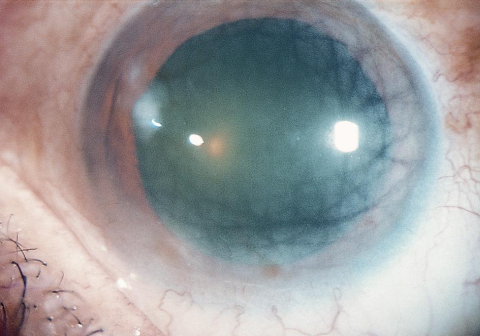Crocodile Shagreen
All content on Eyewiki is protected by copyright law and the Terms of Service. This content may not be reproduced, copied, or put into any artificial intelligence program, including large language and generative AI models, without permission from the Academy.
Disease Entity
Originally described in 1927 by Weizenblatt and named by Vogt in 1930, crocodile shagreen is thought to be a benign, degenerative condition of the cornea which is usually asymptomatic.
Disease
Crocodile shagreen classically appears as bilateral, symmetric, polygonal opacities within the central posterior corneal stroma. The opacities have indistinct edges with intervening clear spaces. The pattern closely resembles “crocodile skin.”
Epidemiology/Risk Factors
It is most commonly associated with advanced age. It may be seen in association with band keratopathy or after traumatic corneal injury. Isolated cases have been reported in pseudoxanthoma elasticum, glaucoma, and polymorphic amyloid degeneration[2].
Etiology/Pathophysiology
It is most likely a degenerative disorder with a non-familial pattern of occurrence (in contrast to Central Cloudy Dystrophy of Francois).
Diagnosis
Histopathology
Electron microscopy has revealed the presence of vacuoles within the corneal stroma, which contain electron-dense material.[2] A sawtooth-like configuration of the collagenous lamellae which make up the corneal stroma is present, and this alteration of the collagenous lamellae may lead to the polygonal opacities observed clinically[2].
Differential Diagnosis
Central Cloudy Dystrophy of Francois, which has autosomal dominant transmission, has a similar clinical appearance; however, as the name implies, it only affects the central cornea. Similar anterior corneal findings have been described with fluorescein staining after pressure patching, ocular hypotony, flattening of keratoconic cornea by a hard contact lens, band keratopathy, and X-linked megalocornea.
Management/Treatment
This condition is not believed to cause reduced vision. No treatment is necessary.
Prognosis
The prognosis is usually very good as the condition is usually asymptomatic.
References
- ↑ American Academy of Ophthalmology. Crocodile shargreen. https://www.aao.org/image/crocodile-shargreen-2 Accessed July 30, 2019.
- ↑ 2.0 2.1 2.2 Belliveau, Brownstein, Agapitos, Font. Ultrastructural Features of Posterior Crocodile Shagreen of the Cornea. Survery of Ophthalmology 2009; 54 (5); 569-575.2. Tripathi RC and Bron AJ. British Journal of Ophthalmology 1975; 59; 59.
- Krachmer, CORNEA, Second edition, 2005, Volume One, p 999.


